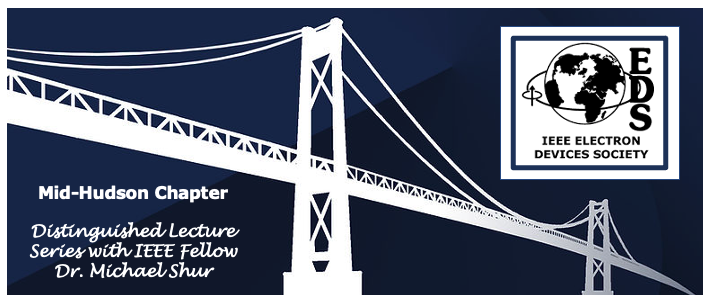IEEE EDS Mid-Hudson Section Distinguished Lecture Series with Dr. Michael Shur
2022 IEEE MHV EDS Distinguished Lecture Series.

The Mid-Hudson Valley Chapter of the IEEE Electron Devices Society is pleased to present a two-part Disitinguished Lecture given by Dr. Michael Shur, Patricia W. and C. Sheldon Roberts Professor of Electrical, Computer, and Systems Engineering and Physics, Applied Physics, and Astronomy.
Date and Time
Location
Hosts
Registration
-
 Add Event to Calendar
Add Event to Calendar
Speakers
 Dr. Michael Shur
Dr. Michael Shur
Lecture #1- Pandemic Equation and Waves of COVID-19 Evolution
In February 2020, our lives changed dramatically by the COVID-19 pandemic, and we have never fully recovered ever since. The COVID-19 pandemic comes in waves. The infection rate, COVID-19-related hospitalizations, and COVID-19-related deaths all rise, crest, and dip and then rise, crest, and dip again. The pandemic waves are caused by the newly emerging virus strains and are affected by the mitigation measures, such as the introduction or removal of the quarantine and vaccination. For these measures to be most effective, the pandemic must be monitored and extrapolated not only at the national and international levels but also locally at the state, county, or even school district, university campus, and company level as well. This is done by the Pandemic Equation, which accurately describes the pandemic metrics and accounts for the “curve flattening” of the pandemic waves and the mitigation measures. Based on the mathematical approach similar to that of the quantum theory of solids, the Pandemic Equation uses the pandemic growth constants slowly varying with time. To describe mitigation and anti-mitigation measures, the Pandemic Equation introduces the generalized Fermi-Dirac distribution functions. The Pandemic Equation parameters extracted from the well-advanced pandemic curves can be used for predicting the pandemic evolution over a limited period of time and comparing different scenarios for future pandemic development. The Pandemic Equation parameter extraction for multiple locations and different periods of time could allow for uncertainty quantification in predicting the pandemic evolution short-term trends.
Biography:
Dr. Michael Shur is Patricia W. and C. Sheldon Roberts Professor at Rensselaer Polytechnic Institute and co-founder of Sensor Electronics Technology, Inc., and Electronics of the Future, Inc. He is a Life Fellow of the National Academy of Inventors, IEEE, APS, ECS, OSA, SPIE, and Fellow of AAAS, IOP, and IET. His awards include IEEE and IET Awards, Tibbetts Award for Technology Commercialization, Gold Medal of Russian Education Ministry, Senior Humboldt Research Award, RPI Research Awards, Best Paper Awards, and St. Petersburg Technical University and University of Vilnius Honorary Doctorates. He is an IEEE EDS and Sigma Xi Distinguished Lecturer and a Foreign Member of the Lithuanian Academy of Sciences.
Email:
Address:Troy, New York, United States, 12180
 Dr. Michael Shur
Dr. Michael Shur
Lecture#2 - Counter-Intuitive Physics of Ballistic Transport in the State-of-the-Art Silicon CMOS
In small enough semiconductor devices, the electron mean free path for collisions with impurities and lattice vibrations exceeds the device size. Such collisionless electron transport is called “ballistic” or “quasi-ballistic”. The electron mean free path in silicon at room temperature is on the order of 20 to 50 nm. This is much greater than the 5 nm minimum feature size of modern silicon CMOS with the channel lengths on the order of 20 nm. Such transistors are used, for example, in the iPhone 12. The current-voltage characteristics of the quasi-ballistic Si CMOS look similar to those of much longer transistors. But the physics of the ballistic transport is very different, counter-intuitive, and has important qualitative consequences for the design of the advanced Si CMOS integrated circuits. Since electrons hit contacts more often in short channel devices, the measured field-effect transistor mobility is determined by “the ballistic mobility” proportional to the device length. At high frequencies, the electron inertia starts playing an important or even a dominant role. The device impedance becomes strongly affected by the electron inertia. The waves of the electron density (plasma waves) enable the Si CMOS response well into the terahertz (THz) range of frequencies. At high excitation levels, these waves are transformed into shock waves. The rectification and instabilities of the plasma waves enable a new generation of THz and sub-THz plasmonic devices. These devices could be implemented in Si, p-diamond, III-V, and III-N materials systems. The 300 GHz band 6G Wi-Fi, advanced homeland security, VLSI testing, and cancer detection are but examples of applications of this plasmonic technology, which is sensitive to the phase of the impinging THz radiation. New emerging plasmonic applications include a field-effect transistor THz spectrometer, a traveling wave THz detector, a THz frequency to digital converter, THz scanning cyber hardware security, and tunable “twisted plasmon” absorbers.
Agenda
1. IEEE and MHV EDS Overview - 5 min
2. Distinguished Lecture #1: Physics-based approach to monitoring pandemic evolution - 30min
3. Distinguished Lecture #2: Counter-Intuitive Physics of Ballsitic Transport in the State-of-the-Art Silicon CMOS - 30 min
This event is sponsored by the IEEE Electron Devices Society (EDS), Mid-Hudson Valley (MHV) chapter.
